Let’s think back to the early days of social media for a moment, and how it impacted our marketing.
Not only did it bring the potential of massive free exposure, it radically increased transparency as well. Every good or bad customer experience suddenly became a potentially viral story. And thus the relation between business and consumer was changed, forever.
But social media isn’t at the top of the digital food chain anymore. As of 2015, messaging apps have overtaken social networking apps in monthly active users.
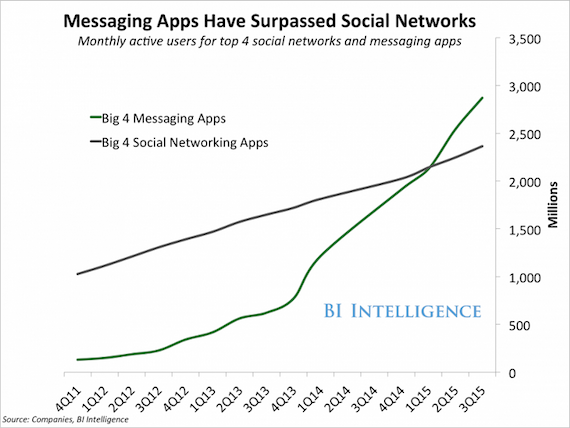
This balance tip coincided with a few other developments: Facebook’s launch of Messenger for Business, WhatsApp announcing a move into B2C communication, an increasing reliance by businesses on message-based communication tools like Slack, and advancements in artificial intelligence (AI) entering a critical phase. The last point was nicely illustrated by AlphaGo wiping the floor with our human champions in Go.
Chris Messina, the guy who brought us the #hashtag, noticed the interplay between these developments, and concluded in a post on Medium that we’re at the brink of another revolution in B2C relationships.
Where before you would use your messaging apps for simple interactions with friends, the above developments allow them to be used for real-time conversations with businesses as well – whether that’s with a service rep or an intelligent chatbot. He dubbed this new era of B2C relationships ‘conversational commerce’.
So, how can you take advantage of this development? How can you integrate real-time communication into your existing marketing stack?
First, let’s clarify why you’ll want to jump aboard this trend in the first place. Then we’ll share some ideas and company examples that will help you start off today.
The Promise of Real-Time Communication
For years, marketers have known the power of ‘now’. Pay attention to the banners and billboards you’ll run into throughout the rest of the day, and notice how often they’re filled with maxims like ‘instant access’, ‘same day delivery’, and ‘quick checkout’. Immediacy strongly impacts our buying behavior.
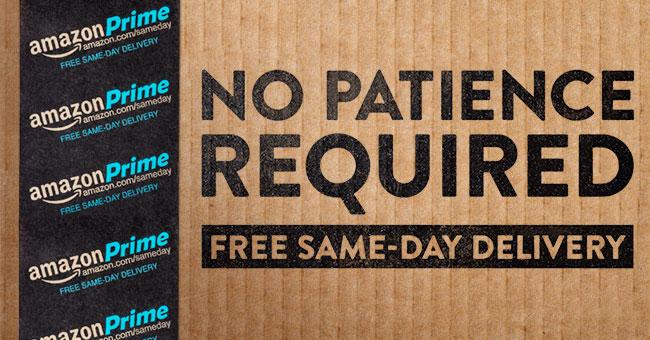
In The Art of Thinking Clearly, Rolf Dobelli shares an experiment into our weakness for ‘right now’ with two groups of participants.
Group A was asked whether they would rather receive $1,000 in 12 months, or $1,100 in 13 months. Most chose the 13-month option, because where else will you find an investment option with a 10% monthly interest rate?
Group B was offered a slightly different choice. They could choose to receive $1,000 today, or $1,100 in one month. Here, most people choose the $1,000 today option. This is remarkable. The choice is basically the same – except that the $1,000 today targets our weakness for wanting things right now. That’s hyperbolic discounting, our irrational preference for what we can get now over what we can get in the future.
Real-time customer service has a similar effect on our preference for right now. According to a Forrester Research study, 57% of online customers leave a website if they don’t receive a quick answer on their question.
This was confirmed in a case study with Intuit, the company behind the financial products QuickBooks and Mint. By placing live chat for real-time support during its checkout process, Intuit increased its average order value by 43%.
From “Interaction” to “Relation”
A major benefit of communication via messaging apps is that it results in a permanent and low-barrier connection with the customer.
Once a phone call with a customer is over, the connection is broken. That is not the case with email, but email has a high barrier to contact compared to writing a message on Facebook.
A permanent low barrier connection promises a major increase in customer interaction – keeping your business top of mind and always accessible.
Also, when a conversation picks up again, it happens within the context of a messaging thread. This makes it easier for support reps to understand the situation and provide a good answer. While emails and phone calls are mere snapshots, messaging threads represent long-term relationships.
Lower Costs per Interaction
As mentioned above, the existing messaging thread will prevent duplication. Things become more efficient when customers don’t have to repeat their issue with every service handover – not to mention more pleasant.
At the same time, advancements in natural language processing fuel expectations of chatbots soon solving many support questions that humans are tackling at the moment. Not all, of course. But a modest 20% would already represent a huge gain in efficiency.
We’re still some years away from scenes like in the movie Her, in which we’re having natural conversations with smooth sounding chatbots that are indistinguishable from those with humans. What is closer and easier to picture, however, is a sort of ‘chat cyborg’ – a human service rep that uses AI to deliver a superior service.
When a question comes in, AI runs it through the database of customer interactions and offers answer suggestions to its human colleague. The human serves as the last check, and can choose to override the suggestions or adjust them. The AI learns from the answer that is given, as well as the response from the customer (was it the right response?). That way, the chat cyborg is continuously growing in smarts and efficiency.
Now let’s look at how you can start with reaping the fruits of these developments today.
How to Get Started With Real-Time Communication
Live Chat on your Site
Web chat has been around for some years, but is developing fast together with the abovementioned trends. You implement a live chat window on your website, through which visitors can reach out and receive support.
Live chat offers many of the benefits described above, such as the power of instant support and minimizing duplication. What makes it especially powerful is that the chat is available at a critical moment in the buyer’s journey – on the website.
A customer might be ready to buy, but has some small concerns or questions before doing so. With live chat there’s no need to delay the purchase, since questions can be resolved on the spot.
A great example of how to do chat right is Apple’s live chat service.

If you’re an Apple user, I recommend you try it out next time you have a service question. You receive full and detailed answers in no time, which suggest they make use of an intelligent knowledge base in the backend.
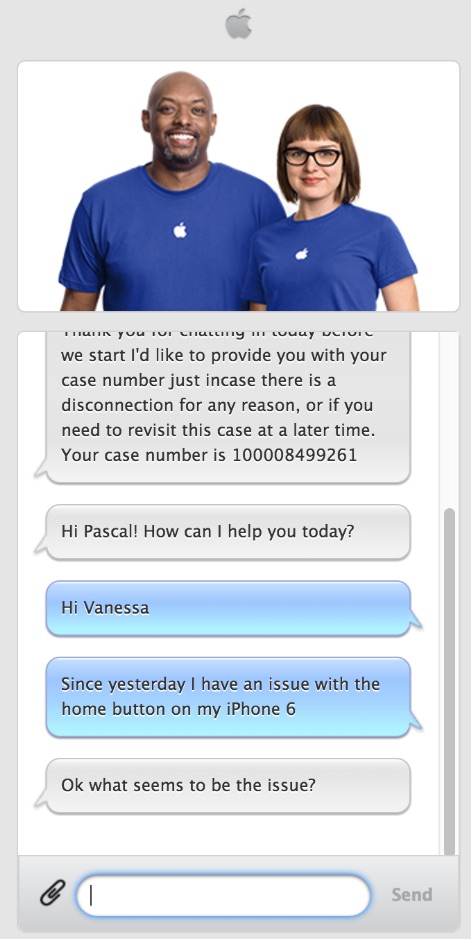
Facebook’s Messenger for Business allows live chat providers to connect to their platform, and tools like Telegram and WeChat are open for this as well. We can expect tighter integrations between website chat and messaging support in the future.
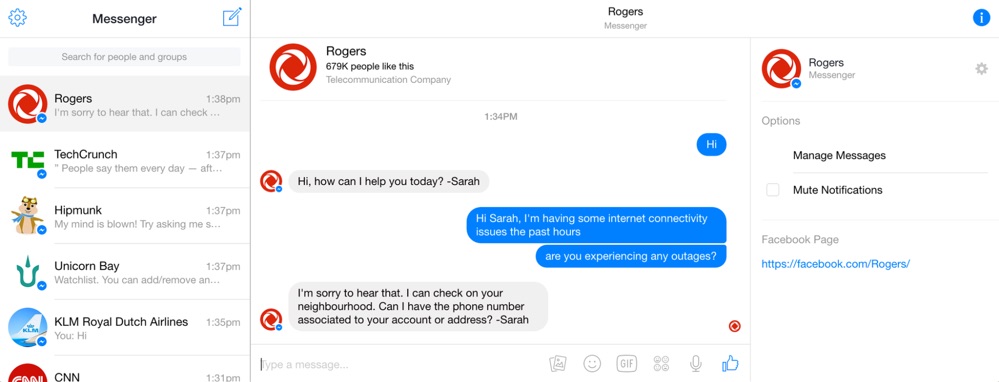
Messaging support
Messaging support is very promising, simply because it’s so darn convenient for consumers. They send a question through their favorite messaging app, and receive an answer in their back pockets.
For this to work, you need to hook up your support team to your messaging channels – be it Facebook, WhatsApp, WeChat, Telegram, or a combination – and let your customers reach out to you.
One example of a business deploying large scale messaging support is Livecrowd, a Dutch company offering next-level customer service and experience for mass crowd events. Think festivals, football matches, or concerts (see Beyoncé’s concert page below). Such events are major logistical challenges. A quick and easy way to advise visitors about transport or safety is invaluable.
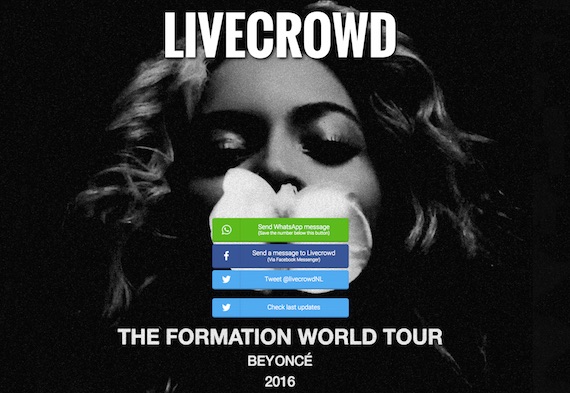
Another messaging example from the Netherlands is KLM, Royal Dutch Airlines. Since a few weeks, they’ve added Facebook Messenger support to their booking process.
This makes it easy for flyers to check the status on their flights and ask support agents any questions:
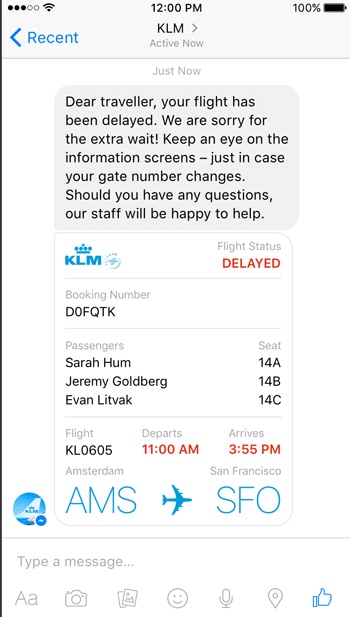
When you’re booking a flight and are logged into your Facebook account, you can select to stay updated about your flight through messenger. When you have a delay, for example, you receive an update on the app. You can also receive your boarding pass through Messenger, or ask questions to the KLM service team directly.
As you can see, part of KLM’s messaging support is automated. Which brings us to the next application.
Chatbots
Chatbots are a hot and exciting area of the tech industry, mainly because they’re fueled by advancements in machine learning.
Slack allows you to connect an existing chatbot to your team or build one with its own logic, while Facebook’s Chatbot API allows you to build a bot for Messenger. There are also plenty of third party apps that allow you to set up a chatbot fairly easily, such as Motion AI.
One example of the extensive use of chatbots is Call of Duty. Players can connect with Lieutenant Reyes chatbot, and solve a not-so-easy-to-solve puzzle. This chatbot sent over six million messages to its gamers in total.
Chatbots will only become more interesting with the continuous advancements in machine learning. The more intelligent the chatbots become, the more customer interactions can be left to them.
How to Get Started
Make a comprehensive communication plan.
To get started with real-time communication, you’ll need to integrate it in a comprehensive communication plan. Ask yourself: What channels make sense for me and my customers?
Set up a dedicated service team.
The fact that conversational commerce is based on text means that compared to phone, more interactions could be done per service agent. But you’ll also have a lower barrier for contact, so you can expect the number of customer interaction to rise. You’ll need a dedicated real-time communication team to support this.
Empower frontline employees.
In real-time communication, speed is king. Zendesk stated that customer satisfaction in live chat dropped after 30 seconds of waiting. Since you’ll be having so many customer inquiries requiring fast responses, it’s essential to empower your frontline employees to resolve issues themselves. The number of cases that require involvement from higher up should be minimized.
Set up communication guidelines.
That doesn’t mean your real-time communication should be a free-for-all. On the contrary, it takes directed effort to maintain a consistent voice across all channels. Like The Economist maintains a style guide for its articles, you should require a style guide for your real-time communication as well. On what level of familiarity will you communicate? If you’ll speak in English, will it be British or American?
Play together with your other channels.
In the world of conversational commerce, one-on-one conversations will cover a much wider area of topics than before. That’s why your frontend employees need to be well aware of all external communications. Whether it’s social media, content, email, or performance marketing – your real-time communication channel needs to be in sync.
Track key metrics.
One key benefit of written communication is that it can easily be tracked. Most live chat solutions, for example, have standard integrations with analytics solutions like Google Analytics and Kissmetrics. With them, it’s easy to measure key indicators of quality communication: first response time, handovers per issue, service ratings, etc.
Conclusion
We really do seem to be at the brink of another revolution in the relationship between businesses and customers.
You can start reaping the benefits of real-time communication today, by taking the first steps with website chat, messaging support, and chatbots. Happy chatting!
About the Author: Pascal van Opzeeland is CMO of Userlike, software for website and messaging support. He and his team share tips about customer communication on the Userlike Blog.